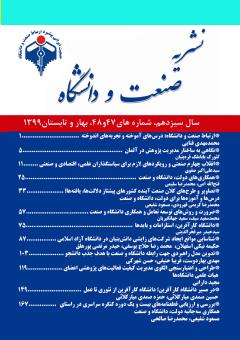انقلاب چهارم صنعتی و رویکردهای لازم برای سیاستگذاران علمی، اقتصادی و صنعتی
محورهای موضوعی : عمومى
1 - استاد
کلید واژه: انقلاب چهارم صنعتی, فرآیندهای تولید, چالشهای کلان, فناوری, زیرساختها.,
چکیده مقاله :
بدون شک تحولات ناشی از فناوری های جدید در سال های اخیر شیوه نگاه ها و تمام ابعاد علمی، اجتماعی، اقتصادی و صنعتی در جهان را تغییر داده است. این تغییرات با سرعتی بسیار بیشتر از گذشته در حال افزایش است و لذا افراد آگاه در هرجامعه چه از جایگاه فردی و چه از جایگاه مدیریتی خود را برای این تغییرات مهیا می نمایند و افراد و جوامع مستعضعف (از دیدگاه فکری، مدیریتی و برنامه ریزی) روز به روز از قافله رشد و تعالی عقب تر خواهند ماند. بعنوان مثال، یک نگاه کوتاه و حتی ساده به آثار فناوری های اطلاعات و ارتباطات در چند دهه گذشته می تواند توجه کافی به تغییرات در تعاملات اجتماعی، شکل بازارهای ملی و بین المللی، رویکردهای اقتصادی و موضوعات امنیتی کشورها را روشن نماید. موج چهارم صنعتی یا (Industry 4.0) یکی از این تحولات فناورانه است که به عنوان یک انقلاب و با همان معنی متداول انقلاب در حال بوقوع پیوستن است. موج چهارم صنعتی به چهارمین انقلاب صنعتی اشاره دارد. این انقلاب فرایندهای تولید را تغییر خواهد داد و باعث می شود تا زنجیره های عرضه و فرایندهای تولید بیشتر به هم متصل شده، کارآمد و انعطاف پذیر باشند و هم بحث سفارشی سازی و تولید مجازی گسترش می یابد. هر کس در مورد موج چهارم صنعتی صحبت می کند. اما این معنی دقیقا چیست؟ و قبل از آن چه بود؟ هدف از اين نوشتار بررسی جامعی از تحولات و فناوری های آینده و اثرات آنها بر صنایع و سایر ابعاد اجتماع است. با درک تحولات دیجیتالی پیش رو، ما باید نتایج تحقیق ها و دستورالعمل ها یا راه حل های ممکن را بررسی کنیم. در این راستا 1. سیاست ها و نقشه راه که همه صنایع مرتبط باید جهت موفقیت در آینده به دنبال باشند، 2. چالش های نظری و همچنین عملی و راه حل های ممکن مرتبط، 3. تغییر در رویکردهای مدیریتی و آموزشی و محتویات رشته های علمی ، مورد اشاره قرار خواهد گرفت.
Undoubtedly, the developments resulting from new technologies in recent years have changed the way views and all scientific, social, economic and industrial dimensions in the world. These changes are increasing much faster than before, and therefore aware people in any society, both from an individual and managerial position, prepare for these changes, and vulnerable individuals and communities (from an intellectual, managerial, and program perspective). They will lag behind the caravan of growth and excellence day by day. For example, a brief and even simple look at the effects of information and communication technologies over the past few decades can shed light on changes in social interactions, the shape of national and international markets, economic approaches, and security issues. The fourth wave of industry or (Industry 4.0) is one of these technological developments that is taking place as a revolution and with the same common meaning of revolution. The fourth industrial wave refers to the fourth industrial revolution. This revolution will change production processes, make supply chains and production processes more interconnected, efficient and flexible, and expand the discussion of customization and virtual production.Everyone is talking about the fourth wave of industry. But what exactly does this mean? And what was it before that? The purpose of this article is a comprehensive review of future developments and technologies and their effects on industry and other dimensions of society. Understanding the emerging digital developments, we need to review the results of research and possible guidelines or solutions. In this way 1. Policies and roadmaps that all related industries should pursue to succeed in the future; 2. Theoretical as well as practical challenges and possible related solutions, 3. Changes in managerial and educational approaches and the contents of scientific disciplines, Will be mentioned.
1. Olivier Scalabre, "The next manufacturing revolution" TED Talk, 2016.
2. Maqbool Khan, Xiaotong Wu, Xiaolong Xu, and Wanchun Dou. "Big data challenges and opportunities in the hype of industry 4.0.", 2017 IEEE International Conference on In Communications (ICC), pp. 1-6. IEEE, 2017.
3. Industry 4.0, Study for the ITRE Committee, European Parliament, 2016. http://www.oecd.or
4. http://www.oecd.org/
5. World Bank Report studies, "Impact of Industry 4.0 technologies on viability GEOGRAPHY: GLOBAL PUBLISHED: 25 OCT 2017.
6. Unleashing the Potential of Connected Products and Services, IIoT WEF Report 2014.
7. Shift towards an integrated digital and human workforce, IIoT WEF Report 2014
8. The Future of Jobs Employment, Skills and Workforce Strategy for the Fourth Industrial Revolution, WEF, Report 2016.
9. Going Digital: The Future of Work for Women, OECD, 2017
10. E. Commission, “EYE@RIS3,” Smart Specialization Platform, (2016). Available at: http://s3platform.jrc.ec.europa.eu/eye-ris3. (2016, December 20).
11. PwC, “Industrie 4.0: Chancen und Herausforderungen der vierten industriellen Revolution,” (2015). Available at:
12. http://www.strategyand.pwc.com/media/file/Industrie-4-0.pdf.
13. J. Lee, B. Bagheri, H.A. Kao, Manuf. Lett., 3 (2015) 18– 23.
14. B. Schätz, M. Törngren, S. Bensalem, M.V. Cengarle, H. Pfeifer, J. McDermid, R. Passerone, Alberto, Sangiovanni-Vincentelli, “CyPhERS: Cyber-Physical European Roadmap & Strategy,” Brussels, 2015.
15. M. Hermann, T. Pentek, B. Otto. Design principles for industrie 4.0 scenarios. Proc. Annu. Hawaii Int. Conf. Syst. Sci. (2016) 3928–3937.
16. Joint Research Centre (JRC), How
17. will standards facilitate new production systems in the context of EU innovation and competitiveness in 2025, (2012).
18. H. Kagermann, W. Wahlster, J. Helbig, “Securing the future of German manufacturing industry: recommendations for implementing the strategic initiative INDUSTRIE 4.0” Frankfurt/Main, 2013.
19. M. L. Garcia and O. H. Bray. Fundamentals of Technology Roadmapping. Distribution. 4205 (1997) 34.
20. S. Engell, et al. "Proposal of a European research and innovation agenda on cyber-physical systems of systems" available at: http://www.cpsos.eu/roadmap, 2016


